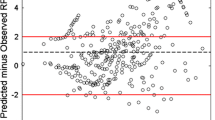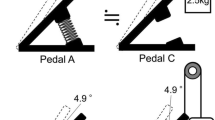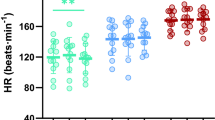Abstract
Methodical aspects of the relationship between pedalling rate and rotating mass and perceived exertion rating (PER; Borg, 1962) were studied in trained, untrained, and ill subjects in bicycle ergometry. Pedalling rate varied between 40 and 100 rpm, work load steps were 5, 10, 15 and 20 mkp/sec in the healthy subjects, and 2.5, 5, 7.5 and 10 mkp/sec in the patients.
PER decreased with increasing pedalling rate in all healthy subjects. In the patients, PER increased moderately at work load of 2.5 mkp/sec, but decreased at higher work loads up to 80 rpm, followed by a slight increase at 100 rpm. Higher mass of the flywheel, studied in 6 trained subjects, lowered the PER insignificantly. In the healthy subjects, test criteria, such as reproducibility, reliability, sensitivity, and linearity remained almost unaffected by pedalling rate. In patients, increasing pedalling speed diminished reproducibility and sensitivity. The strictness of the PER work load relationship is lowered at higher pedalling rate, especially at 100 rpm. When using the PER scale, pedalling rate has to be considered as an factor of main influence.
Similar content being viewed by others
References
Arstila, M.: Pulse-conducted triangular exercise-ECG test. Acta med. scand. Suppl.529, 1–112 (1972)
Banister, E. W., Jackson, R. C.: The effect of speed and load changes on oxygen intake for equivalent power outputs during bicycle ergometry. Int. Z. angew. Physiol.24, 284–290 (1967)
Bar-Or, O., Skinner, J. S., Buskirk, E. R., Borg, G.: Physiological and perceptual indicators of physical stress in 41- to 60-year-old men who vary in conditioning level and in body fatness. Med. Sci. Sports4, 96–100 (1972)
Blohmke, M.: Belastungstests des Kreislaufs in Epidemiologie und Präventivmedizin. Heidelberg: Hüthig 1969
Borg, G.: Physical performance and perceived exertion. Thesis, Lund 1962
Borg, G.: Perceived exertion as an indicator of somatic stress. Scand. J. Rehab. Med.2–3, 92–98 (1970)
Borg, G.: Relative response and stimulus scales. Rep. Inst. Appl. Psychol., University of Stockholm, p. 1 (1970)
Borg, G.: Personal communication (1972)
Borg, G., Dahlström, H.: The reliability and validity of a physical work test. Acta physiol. scand.55, 353–361 (1962)
Borg, G., Linderholm, H.: Perceived exertion and pulse rate during graded exercise in various age groups. Acta med. scand.181, 194–206 (1967)
Documenta Geigy: Wissenschaftliche Tabellen, 7th ed. Basel 1967
Eckermann, P., Millahn, H. P.: Der Einfluß der Drehzahl auf die Herzfrequenz und die Sauerstoffaufnahme bei konstanter Leistung am Fahrradergometer. Int. Z. angew. Physiol.23, 340–344 (1967)
Edwards, R. T. H., Melcher, A., Hesser, C. M., Wigertz, O., Ekelund, L. G.: Physiological correlates of perceived exertion in continuous and intermittent exercise with the same average power output. Europ. J. clin. Invest.2, 108–114 (1972)
Heymanns, C., Neil, E.: Reflexogenic areas of the cardiovascular system. London: Churchill 1958
Israel, S., Brenke, H., Donath, R.: Die Abhängigkeit einiger funktioneller Meßgrößen von der Trittfrequenz (Umdrehungszahl) bei der Fußkurbelergometrie. Med. Sport (Berl.)7, 65–68 (1967)
Löllgen, H., Ulmer, H.-V.: The preferred pedalling frequency of patients in bicycle ergometry (Zum Problem der Tretgeschwindigkeit in der Ergometrie). III. Int. Seminar für Ergometrie, Berlin (1972), pp. 130–135. Berlin: Ergon 1973
Maidorn, K., Stoboy, H., Wagner, A.: Die Abhängigkeit der Leistungspulssumme von der Rotationsenergie der Schwungmassen eines Ergometers. Z. KreislForsch.6, 597–603 (1967)
Mellerowicz, H., Roskamm, H., Hettinger, T., Hollmann, W., Kraus, E., König, K., Mies, H., Reindell, H., Stoboy, E.: Vorschläge zur Standardisierung der ergometrischen Leistungsmessung. Z. KreislForsch.53, 856–860 (1964)
Müller, E. A.: Fahrradergometer — Gradmesser der Muskelarbeit. Radmarkt4, 14–17 (1952)
Pryss, C.: Zur Gültigkeit der Johanssonschen Regel für Fahrradergometerarbeit. Diplomarbeit, Mainz 1972
Skinner, J. S., Hutsler, R., Bergsteinova, V., Buskirk, E. R.: The validity and reliability of a rating scale of perceived exertion. Med. Sci. Sports5, 94–96 (1973)
Skinner, J. S., Hutsler, R., Bergsteinova, V., Buskirk, E. R.: Perception of effort during different types of exercise and under different environmental conditions. Med. Sci. Sports5, 110–115 (1973)
Stegemann, J., Ulmer, H.-V., Heinrich, K. W.: Die Beziehung zwischen Kraft und Kraftempfindung als Ursache für die Wahl energetisch ungünstiger Tretfrequenzen beim Radsport. Int. Z. angew. Physiol.25, 224–234 (1968)
Ulmer, H.-V.: Die Abhängigkeit des Leistungsempfindens von der Tretfrequenz bei Radsportlern. Sportarzt u. Sportmedizin20, 385–393 (1969)
Ulmer, H.-V.: Die Tretgeschwindigkeit von Radsportlern bei Bahnrennen und Ergometerversuchen. Sportarzt u. Sportmedizin24, 77–83 (1973)
Voigt, E.-D., Engel, P., Klein, H.: Über den Tagesgang der körperlichen Leistungsfähigkeit. Int. Z. angew. Physiol.25, 1–12 (1968)
Wilcoxon, F., Katti, S. K., Wilcox, R. A.: Critial values and probability. Cevels for the Wilcoxon rank sum test and the Wilcoxon signed rank test. Lederle Lab., Pearl River, New York, August 1963
Author information
Authors and Affiliations
Rights and permissions
About this article
Cite this article
Löllgen, H., Ulmer, H.V., Gross, R. et al. Methodical aspects of perceived exertion rating and its relation to pedalling rate and rotating mass. Europ. J. Appl. Physiol. 34, 205–215 (1975). https://doi.org/10.1007/BF00999934
Received:
Issue Date:
DOI: https://doi.org/10.1007/BF00999934




